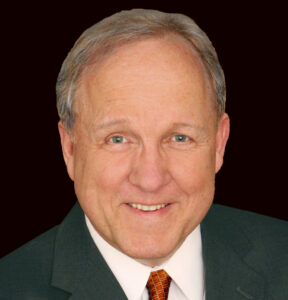Leadership Lessons
Early in his career, Rodger Dean Duncan interviewed interesting people like Lyndon Johnson, comedian Jack Benny, Baroness Maria von Trapp, pollster George Gallup, and anthropologist Margaret Mead. He traded jokes with Norman Rockwell and discussed home carpentry with Robert Redford.
Later, as a leadership consultant, he advised cabinet officers in two White House administrations and coached C-suite executives in dozens of Fortune 500 companies. He also headed global communications at Campbell Soup Company. He received his PhD in organizational behavior at Purdue University, and writes a regular column for Forbes.
Duncan’s latest book LeaderSHOP: Workplace, Career, and Life Advice From Today’s Top Thought Leadersis a collection of lessons from these interviews.
Change Your View
Like you, I’ve interviewed many leadership experts. Were there any surprising interviews that gave you a different perspective?
The interviews for LeaderSHOP certainly provide some thought-provoking perspectives.
Drew Dudley emphasizes the value of regarding every new day as a fresh start and an opportunity for self-reflection on specific behaviors. Leadership, he says, is not a title or accolade. It’s a daily choice about personal practices. His Day One approach to personal management involves making your life less about living up to the expectations of others and more about a disciplined commitment to acting on your core values each day.
In discussing purpose and meaning at work, Dave and Wendy Ulrich highlight the importance of humility in the leader. Humility, they say, is at the heart of a growth mindset that encourages and unleashes learning that, in turn, gives meaning to work and fosters engagement.
Bill George talks about how “authentic” leadership is made possible when the practitioner follows an internal “true north” compass of selflessness and integrity.
Elizabeth Crook emphasizes that our gifts are found at the intersection of what energizes us and what we know how to do. Hint: it’s probably something you’ve been doing in one way or another most of your life.
Hugh Blane talks about a mindset he calls JDTM—Just Doing the Minimum—and how getting clarity on what lights your internal fire can be a critical step toward high achievement.
Rob Fazio gives specific examples of how honest conversation is the key to handling office politics. He also says that listening is bad for your health—that is, listening to discouraging messages from others or to negative self-talk.
Ann Rhoades, former Chief People Officer at Southwest Airlines, underscores the importance of rewarding behaviors that are the foundation of the culture you want—and taking quick and decisive action when expected behavioral norms are violated.
Social psychologist Dan Cable talks about a de-motivator he calls “learned helplessness,” and he explains how leaders can create a work environment that encourages smart risk.
Ira Chaleff reveals the secrets of saying “No!” without getting fired, explaining the situations in which refusing a directive is not insubordination but rather smart collaboration.
Jim Kouzes explains how a feedback-friendly work environment is to everyone’s benefit and why dialogue skills are a hallmark of effective leadership.
Carmine Gallo teaches communication techniques used by great presenters as disparate as Steve Jobs and Pope Francis. The “Rule of Three,” he says, has been used by everyone from Thomas Jefferson to Goldilocks.
Career coach Mary Abbajay discusses approaches to “managing up”—dealing proactively with an incompetent manager in a way that doesn’t derail your career. She suggests tactics ranging from keeping the manager (overly) informed to building your own reputation by filling in where the manager is deficient.
Marshall Goldsmith and Sally Helgesen talk about how striving for perfection can serve you well early in your career (because it supports doing outstanding work), but it can later hold you back because being so invested in precision can dissuade you from taking the kind of risks that characterize strong leaders.
Other people I interviewed—like Brian Tracy, Tom Rath, Jodi Glickman, Laura Vanderham, and Stephen M.R. Covey—provide a rich mosaic of ideas on leadership and personal development. People tell me the individual conversations are interesting, but the real value is having them all in one place that provides insightful “connective tissue.”
How Leaders Impact Culture
Culture is a big topic in leadership circles. Share a few ways leaders best impact culture for the positive.
Leaders have—or at least should have—a disproportionately strong influence on the organization’s culture. Good leaders exercise positive influence on the culture by performing CPR.
For lifeguards and other rescue personnel, “CPR” stands for Cardio-Pulmonary Resuscitation, a method for breathing life into a drowning person. In this instance, CPR stands for Converse, Practice and Reinforce—a way to breathe life and vitality into an organization.
In a typical business, people are pretty good at the Converse part. They can rattle off a list of values or valued behaviors that the company claims to embrace—things like Accountability, Innovation, Integrity, Quality, Respect, Teamwork.
The Practice part is a bit more challenging. This involves actually doing what you say you value. A critical part of strong leadership is the degree to which what you profess and what you practice are in alignment.
The Reinforce part requires even more effort. Reinforcement involves specific and deliberate application of affirmation, encouragement and “rewards” for positive behavior. It also involves specific, deliberate and friendly correction of negative behaviors.
In this context, how does CPR work?
Here’s an example. The new CEO of a multi-billion-dollar service company was hired to reverse a serious decline in the business. He was concerned about turf protection and other forms of infighting that had become a cancer to the corporate culture.
Shortly after coming on board, he grabbed a can of spray paint and walked into the executive parking lot (knowing full well that hundreds of employees could see him from their windows in the headquarters building). Executive parking symbolized the “privilege of rank” that was a sore spot with many workers. The CEO went to each parking space and methodically sprayed paint over the name of the executive on the sign in front of the car. Then he walked inside and got on the intercom system that previously was used only for fire drills.
“Good morning, ladies and gentlemen,” he said. “Some of you were watching me out in the parking lot. You were probably wondering ‘What’s that idiot doing out there?’ No, I’m not firing our senior executive team. I just want to emphasize that we’re all in this boat together, and we need to row in unison. Last year this company lost $156 million. We need to invest our collective energy in working together for solutions, not fussing about silly things like parking places and the size of office furniture. So starting tomorrow, anybody can park anywhere. If you work in the mailroom and you get here early, the best spot in the lot can be yours. If you’re a senior executive and you come in late, you may get rained on. Have a nice day.”
Gamesmanship? Not really, especially since this CEO followed up with many other genuine acts to emphasize accountability and performance over rank and title.
It’s estimated that 15% of a leader’s effectiveness comes from the Converse part of CPR (what the leader says and teaches). About 35% of a leader’s effectiveness comes from the Practice part (the actual behaviors that the leader personally models). And a whopping 50% of a leader’s effectiveness comes from the Reinforce part (how the leader encourages positive performance and corrects negative performance).
Reinforcement is really not complicated. You might ask, “Should I reinforce my people for their little day-to-day successes, or should I save up my strokes for when they accomplish something really major?”
The answer to that question lies in the way most volunteers get their work done. (Yes, your people are volunteers. Remember that you can rent their backs and hands, but you must earn their heads and hearts.) The simple fact is that, for most of your people, work is not a string of dazzling successes that they produce one right after another. Instead, the majority of their work consists of somewhat routine activities. They perform most of these quietly and without fanfare.
Leaders do well to stay aware and appreciative of the “behind the scenes” effort expended by their people. Then they’ll be in a position to follow the first rule of positive reinforcement: “Make a big deal about little things.” In fact, giving frequent, specific and genuine reinforcement on positive behavior tends to crowd out negative behavior.
Mistakes
As you know, I wrote a book about mistakes. What mistakes are common for leaders? Are there any mistakes that are fatal?
Of course an egregious violation of trust can be deadly to a leader’s credibility and therefore to his or her effectiveness. People earn trust over a period of time by making regular deposits in their “trust accounts.” But a major withdrawal from that trust account—such as lying—can deplete the account significantly. Real trust can take years to earn, yet it can be destroyed very quickly.
A more common mistake is often made in innocence (or ignorance). Many leaders make the mistake of assuming people will follow them because they have the leadership “title.” Although people may respect a title, people who hold the title must earn trust and confidence.
Most leaders come into their roles with the expectation that they will make things better. They’re expected to improve corporate earnings, improve the organization’s position in the marketplace, improve its service to stakeholders, or otherwise expand its influence. A new leader is rarely asked to maintain the status quo. The task is defined in various measures of improvement. That means change.
Unfortunately, many well-intended leaders flounder in their change efforts because they try to practice change-by-slogan or change-by-announcement or change-by-pep-rally or change-by-executive-decree. They seem to forget—or perhaps they never knew—that an absolute imperative in sustainable, lasting change is the true engagement of the people affected by and expected to help carry out the change. Unless you genuinely engage the heads, hearts, and hope of people, your change effort is doomed to failure.
Why is lack of engagement so frustrating to people?
 I believe most people sincerely want to be engaged in their work. They want to invest their energy and ingenuity in their work roles. They want to have positive emotions toward their work. They want their work to be meaningful and manageable. They want to have psychological ownership of their work roles. But they often do not.
I believe most people sincerely want to be engaged in their work. They want to invest their energy and ingenuity in their work roles. They want to have positive emotions toward their work. They want their work to be meaningful and manageable. They want to have psychological ownership of their work roles. But they often do not.
Anemic engagement is extremely costly. The Gallup organization estimates that disengagement in the workplace costs American business at least $500 billion a year. While the dollar cost of disengagement is enormous, we should be most concerned about what it does to the human spirit.
If people are our most valuable asset—and I believe they are—we should do everything possible to create work environments that maximize the human resource. That, in turn, is good for the people as well as for the enterprise.
It’s really expensive when an organization’s best and brightest people quit and leave. But it’s even more expensive when the best and brightest people quit and stay.
Poor management of change—which I believe is one of the most common leadership mistakes—is especially frustrating to the best and the brightest because they have a lower tolerance for mediocrity. The most outstanding employees are sometimes penalized from two directions. First, when a change effort is poorly managed, their hopes are dashed. Second, because they are outstanding employees, they’re often asked to pull up the slack of those who aren’t doing their fair share. This is not only unfair, it’s debilitating.
Get Out of Your Comfort Zone
How do leaders challenge others to get out of their comfort zone and achieve what they may think is impossible?
As a young boy I was frequently encouraged by my parents, grandparents, and teachers to “do your best.” You know what I discovered? When I genuinely did my best, my “best” got better.
Sometimes in a speech or workshop setting I’ll ask people to raise their hands as high as they can. Then, while their hands are still up, I ask them to raise them even higher. They always manage to stretch at least another inch or so. They laugh, but the point is made: Regardless of the difficulty of a task, there’s nearly always a way we can improve our performance further.
It’s been said that a comfort zone is a beautiful place—but nothing ever grows there. I know it may sound like a line from a Rocky Balboa movie, but we typically achieve greatness only when we become more committed to our dreams than we are to our comfort zones. Another piece of advice—it’s a cliché but nevertheless true—is that if you want something you’ve never had, you’ll need to do something you’ve never done.
Storytelling is one way leaders can challenge people to abandon their comfort zones. They can tell compelling stories of how peers (or competitors) discovered or developed something important by challenging the status quo, by living out of their imagination rather than being stuck in their memory.
Even small victories in the workplace should be celebrated. Such acknowledgement helps create a “can do” mindset. You can be sure that at the 3M Corporation they still celebrate the out-of-the-box thinking of an employee named Art Fry. When a colleague mixed a sticky-but-not-too-sticky adhesive concoction that did not meet existing standards, Fry abandon his comfort zone and saw the “failed” mixture as a solution in search of a problem. He asked himself the question “Could this stuff be used to make a bookmark that will stick to the page but won’t tear the paper when I move it somewhere else?” The result? The Post-it Note.
For more information, see LeaderSHOP: Workplace, Career, and Life Advice From Today’s Top Thought Leaders.

